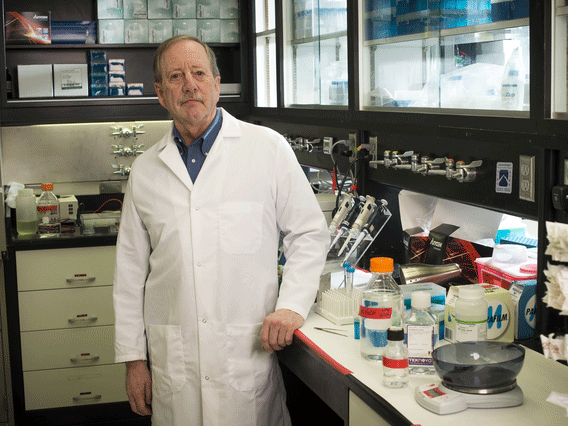Need more information? Contact us
 Steven Austad, Ph.D. The University of Alabama at Birmingham, along other members of the Geroscience Network, has published six manuscripts that map strategies for taking new drugs that target processes underlying aging into clinical trials.
Steven Austad, Ph.D. The University of Alabama at Birmingham, along other members of the Geroscience Network, has published six manuscripts that map strategies for taking new drugs that target processes underlying aging into clinical trials.
Researchers believe these agents hold promise for treating multiple age-related diseases and disabilities. The articles appear today in The Journals of Gerontology: Series A – Biological Sciences and Medical Sciences.
The Geroscience Network, formed by Steven Austad, Ph.D., distinguished professor and chair of UAB’s Department of Biology in the College of Arts and Sciences; James Kirkland, M.D., Ph.D., director of the Mayo Clinic Robert and Arlene Kogod Center on Aging; and Nir Barzilai, M.D., Albert Einstein College of Medicine, consists of 18 academic aging centers, along with the participation of more than 100 investigators from across the United States and Europe. The network is funded by the National Institutes of Health.
“Aging is not just an abstract and intriguing biological problem,” Austad said. “It is the No. 1 cause of death and disability in today’s world. Its threat is very significant, because aging is a major risk factor in a host of other serious diseases and health issues. The Geroscience Network seeks to combine research from a number of institutions to address this ever-growing challenge.”
“Aging is the largest risk factor for most chronic diseases, including stroke, heart disease, cancer, dementias, osteoporosis, arthritis, diabetes, metabolic syndrome, blindness and frailty,” Kirkland said. “Recent research suggests that aging may actually be a modifiable risk factor. The goal of our network’s collaborative efforts is to accelerate the pace of discovery in developing interventions to delay, prevent or treat these conditions as a group, instead of one at a time.”
Austad is the senior author on the manuscript “Evaluating Health Span in Preclinical Models of Aging and Disease: Guidelines, Challenges, and Opportunities for Geroscience,” which assesses how research animals can be best employed to guide the development of therapies that counteract aging processes.
Kirkland is senior author on manuscripts that explore the challenges of developing aging interventions:
- “Barriers to the Preclinical Development of Therapeutics That Target Aging Mechanisms”
- “Frameworks for Proof-of-Concept Clinical Trials of Interventions That Target Fundamental Aging Processes”
The first manuscript summarizes discussions held at a 2014 Geroscience Network retreat. While research efforts have successfully identified new drugs that extend lifespan in animals, the authors discuss the need to develop a consistent preclinical pipeline for drug development that focuses on best practices for drug discovery, development of lead compounds, translational preclinical biomarkers, funding and support for preclinical studies, and integration between researchers and clinicians.
In the second manuscript, the researchers acknowledge that aging therapies may hold “great promise” for enhancing the health of a wide population, with clinical trials’ being a critical step for translating therapies from animals into humans. The manuscript is built on the outcomes of an international meeting funded through the National Institutes of Health R24 Geroscience Network.
The other manuscripts published are:
- “Strategies and Challenges in Clinical Trials Targeting Human Aging”
- “Resilience in Aging Mice”
- “Moving Geroscience Into Uncharted Waters”
Felipe Sierra, Ph.D., of the National Institute on Aging and a member of the Geroscience Network, describes the potential impact of aging discoveries in his manuscript, “Moving Geroscience Into Uncharted Waters.”
Sierra said, “In addition to the direct health issues, it has been calculated that care for the elderly currently accounts for 43 percent of the total health care spending in the U.S., or approximately $1 trillion a year, and this number is expected to rise as baby boomers reach retirement age. Reducing these costs is critical for the survival of society as we know it, and a 2013 paper by Dana Goldman and colleagues calculated that a modest increase in lifespan and health span (2.2 years) could reduce those expenses by $7 trillion by 2050.”
“While significant work has already been accomplished, there is much more to be done as we focus on translating findings into practice,” Kirkland said. “The Geroscience Network is a collaborative way to overcome barriers and move us closer to our shared goal of increasing health span — the healthy, independent years of life for the elderly.”
In addition to UAB, members of the Geroscience Network are Albert Einstein College of Medicine, Buck Institute for Research on Aging, Harvard University, the Mayo Clinic, Johns Hopkins University, National Institute on Aging, the Scripps Research Institute, Stanford University, the University of Arkansas, the University of Connecticut, the University of Michigan, the University of Minnesota, the University of Oklahoma, the University of Texas Health Science Center San Antonio, the University of Southern California, the University of Washington and Wake Forest University, as well as members from other institutions across the U.S. and Europe.
This work was supported by the National Institutes of Health, the Paul Glenn Foundation, Nathan Shock Centers of Excellence for the Biology of Aging, the Connor Group, and the Noaber and Ted Nash foundations. Additional acknowledgements include the contributions of the basic researchers and clinicians engaged in research on mechanisms of aging and care of the elderly in the five retreats supported by the R24 grant from the National Institute on Aging, as well as a workshop on resilience and aging supported by the National Institute on Aging.